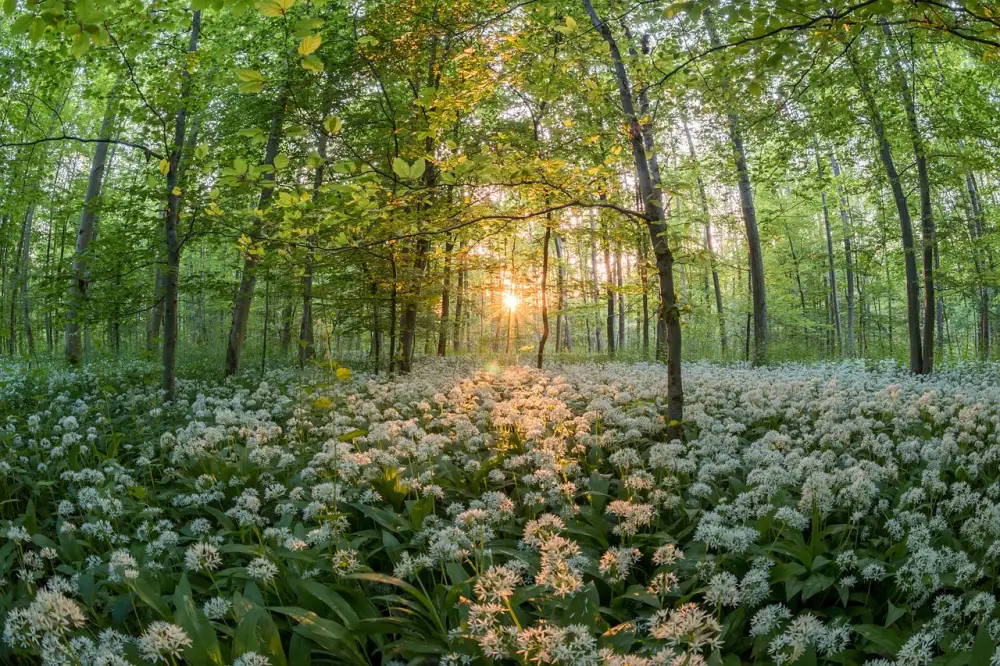Discover the Exquisite Flavors of Wild Garlic: A Culinary Delight Straight from Nature's Bounty

Wild garlic, also known as ramsons or bear's garlic, is a versatile and flavorful herb that grows abundantly in woodland areas. With its distinct aroma and delicate taste, wild garlic has been used for centuries in various cuisines around the world. This leafy green herb is not only delicious but also packed with numerous health benefits. Whether you're a seasoned forager or just starting to explore the wonders of wild foods, discovering the exquisite flavors of wild garlic is sure to be a culinary delight straight from nature's bounty.
Health benefits of wild garlic
Wild garlic not only adds a burst of flavor to dishes but also offers numerous health benefits. It is rich in vitamins A and C, which boost the immune system and promote healthy skin. Additionally, wild garlic contains allicin, a compound known for its antibacterial and antifungal properties. Consuming wild garlic can help lower blood pressure and cholesterol levels, reducing the risk of heart disease. Its antioxidant properties also aid in detoxification and may have anti-cancer effects. Incorporating this versatile herb into your diet can contribute to overall well-being.
Culinary uses of wild garlic
Culinary uses of wild garlic are diverse and exciting, making it a versatile ingredient in the kitchen. The leaves have a mild garlic flavor and can be used as a substitute for regular garlic in various dishes. They can be added to salads, soups, stir-fries, and sauces to enhance the taste and aroma. Wild garlic can also be used to make pesto or infused oils, adding a unique twist to traditional recipes. Its delicate flowers can be used as a garnish or added to salads for an extra pop of color. With its distinct flavor profile, wild garlic is sure to elevate any dish it is added to.
How to forage for wild garlic
Foraging for wild garlic is a delightful way to connect with nature and discover this flavorful herb. Here are some tips on how to find and harvest wild garlic. Look for it in damp woodland areas, near streams or rivers, as it thrives in moist soil. The best time to forage is in spring when the leaves are young and tender. Identify wild garlic by its distinctive smell - a pungent aroma of garlic that fills the air. Carefully pull up the whole plant, making sure to leave some behind for regrowth. Remember to always seek permission before foraging on private land and be mindful of conservation guidelines. Happy hunting!
Popular recipes featuring wild garlic
Popular recipes featuring wild garlic include wild garlic pesto, wild garlic soup, and wild garlic butter. In the pesto recipe, wild garlic leaves are blended with pine nuts, Parmesan cheese, olive oil, and a squeeze of lemon juice. The result is a vibrant green sauce that can be used as a dip or spread. For the soup, wild garlic leaves are sautéed with onions and potatoes before being simmered in vegetable broth. The soup is then pureed until smooth and garnished with a drizzle of cream. Wild garlic butter is made by mixing finely chopped wild garlic leaves with softened butter and a pinch of salt. This flavorful butter can be spread on bread or used to enhance the taste of grilled meats and vegetables. These recipes showcase the unique flavor of wild garlic and allow its delicate aroma to shine through in every bite.
Tips for storing and preserving wild garlic
When it comes to storing and preserving wild garlic, there are a few key tips to keep in mind. First, it's important to handle the leaves and bulbs with care to avoid bruising or damaging them. After foraging, gently wash the wild garlic and pat it dry before storage. To extend its shelf life, wrap the leaves in a damp paper towel and place them in a plastic bag in the refrigerator. Alternatively, you can chop the leaves and freeze them in an airtight container or ice cube trays for later use. Remember to label your containers with the date to keep track of freshness. By following these simple tips, you can enjoy the vibrant flavors of wild garlic all year round.
Precautions and potential side effects of consuming wild garlic
While wild garlic is generally safe to consume, there are a few precautions and potential side effects to be aware of. Some individuals may experience digestive issues such as stomach upset or diarrhea when consuming large amounts of wild garlic. It is also important to note that wild garlic can interact with certain medications, particularly those used to treat blood thinning or antiplatelet conditions. As always, it's best to consult with a healthcare professional before incorporating wild garlic into your diet, especially if you have any underlying health conditions or are taking medication.
In conclusion, wild garlic is a truly remarkable ingredient that not only adds a burst of flavor to dishes but also provides numerous health benefits. Its distinct aroma and taste make it a favorite among chefs and home cooks alike. From soups and salads to pesto and sauces, the culinary possibilities with wild garlic are endless. However, it is important to exercise caution when foraging for wild garlic and ensure that you are picking the correct plant. Additionally, be mindful of potential side effects such as digestive issues or allergic reactions. With proper storage and preservation techniques, you can enjoy the exquisite flavors of wild garlic all year round. So why not venture into nature's bounty and discover the wonders of this culinary delight?
Published: 17. 11. 2023
Category: Food



